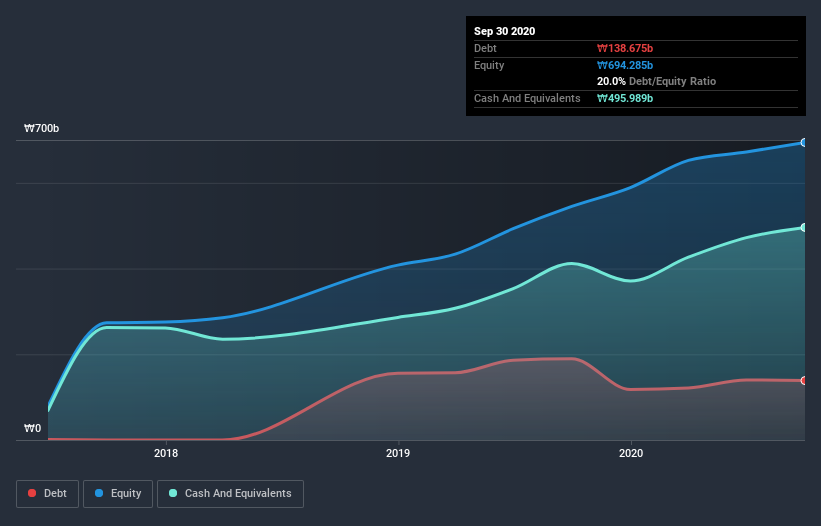- South Korea
- /
- Entertainment
- /
- KOSDAQ:A263750
Pearl Abyss (KOSDAQ:263750) Seems To Use Debt Rather Sparingly
Some say volatility, rather than debt, is the best way to think about risk as an investor, but Warren Buffett famously said that 'Volatility is far from synonymous with risk.' So it seems the smart money knows that debt - which is usually involved in bankruptcies - is a very important factor, when you assess how risky a company is. As with many other companies Pearl Abyss Corp. (KOSDAQ:263750) makes use of debt. But the more important question is: how much risk is that debt creating?
When Is Debt A Problem?
Debt and other liabilities become risky for a business when it cannot easily fulfill those obligations, either with free cash flow or by raising capital at an attractive price. If things get really bad, the lenders can take control of the business. However, a more common (but still painful) scenario is that it has to raise new equity capital at a low price, thus permanently diluting shareholders. Of course, debt can be an important tool in businesses, particularly capital heavy businesses. When we think about a company's use of debt, we first look at cash and debt together.
Check out our latest analysis for Pearl Abyss
What Is Pearl Abyss's Net Debt?
As you can see below, Pearl Abyss had ₩138.7b of debt at September 2020, down from ₩189.4b a year prior. But it also has ₩496.0b in cash to offset that, meaning it has ₩357.3b net cash.

How Healthy Is Pearl Abyss' Balance Sheet?
Zooming in on the latest balance sheet data, we can see that Pearl Abyss had liabilities of ₩131.5b due within 12 months and liabilities of ₩171.0b due beyond that. Offsetting these obligations, it had cash of ₩496.0b as well as receivables valued at ₩61.2b due within 12 months. So it can boast ₩254.6b more liquid assets than total liabilities.
This surplus suggests that Pearl Abyss has a conservative balance sheet, and could probably eliminate its debt without much difficulty. Simply put, the fact that Pearl Abyss has more cash than debt is arguably a good indication that it can manage its debt safely.
And we also note warmly that Pearl Abyss grew its EBIT by 17% last year, making its debt load easier to handle. When analysing debt levels, the balance sheet is the obvious place to start. But it is future earnings, more than anything, that will determine Pearl Abyss's ability to maintain a healthy balance sheet going forward. So if you're focused on the future you can check out this free report showing analyst profit forecasts.
Finally, a business needs free cash flow to pay off debt; accounting profits just don't cut it. While Pearl Abyss has net cash on its balance sheet, it's still worth taking a look at its ability to convert earnings before interest and tax (EBIT) to free cash flow, to help us understand how quickly it is building (or eroding) that cash balance. Over the last three years, Pearl Abyss recorded free cash flow worth a fulsome 89% of its EBIT, which is stronger than we'd usually expect. That positions it well to pay down debt if desirable to do so.
Summing up
While we empathize with investors who find debt concerning, you should keep in mind that Pearl Abyss has net cash of ₩357.3b, as well as more liquid assets than liabilities. The cherry on top was that in converted 89% of that EBIT to free cash flow, bringing in ₩123b. So is Pearl Abyss's debt a risk? It doesn't seem so to us. The balance sheet is clearly the area to focus on when you are analysing debt. But ultimately, every company can contain risks that exist outside of the balance sheet. Case in point: We've spotted 1 warning sign for Pearl Abyss you should be aware of.
If you're interested in investing in businesses that can grow profits without the burden of debt, then check out this free list of growing businesses that have net cash on the balance sheet.
If you decide to trade Pearl Abyss, use the lowest-cost* platform that is rated #1 Overall by Barron’s, Interactive Brokers. Trade stocks, options, futures, forex, bonds and funds on 135 markets, all from a single integrated account. Promoted
New: Manage All Your Stock Portfolios in One Place
We've created the ultimate portfolio companion for stock investors, and it's free.
• Connect an unlimited number of Portfolios and see your total in one currency
• Be alerted to new Warning Signs or Risks via email or mobile
• Track the Fair Value of your stocks
This article by Simply Wall St is general in nature. It does not constitute a recommendation to buy or sell any stock, and does not take account of your objectives, or your financial situation. We aim to bring you long-term focused analysis driven by fundamental data. Note that our analysis may not factor in the latest price-sensitive company announcements or qualitative material. Simply Wall St has no position in any stocks mentioned.
*Interactive Brokers Rated Lowest Cost Broker by StockBrokers.com Annual Online Review 2020
Have feedback on this article? Concerned about the content? Get in touch with us directly. Alternatively, email editorial-team (at) simplywallst.com.
About KOSDAQ:A263750
Reasonable growth potential with adequate balance sheet.
Similar Companies
Market Insights
Community Narratives




